Building your dream home is one of the biggest milestones in life.
But for most people, the construction process feels confusing — with so many technical steps, materials, and timelines involved.
To help you understand it clearly, here’s a step-by-step breakdown of all the major stages of home construction, explained in simple language by a professional builder.
🪜 Stage 1: Site Preparation and Layout Marking
Before any construction begins, your site must be ready for work.
🔹 Activities Involved
Site Cleaning: Remove trees, debris, and old structures.
Boundary & Layout Marking: Using total station or rope, the builder marks the layout based on the approved plan.
Temporary Utilities: Set up temporary power and water connection.
Borewell & Septic Tank: Drilling and placement are usually done at this stage.
✅ Builder’s Tip:
Proper site leveling and drainage setup now prevent waterlogging and foundation issues later.
🧱 Stage 2: Foundation Work
The foundation is the most crucial part of your house — it carries the entire building load.
🔹 Steps Involved
Excavation: Digging trenches or pits as per structural design.
PCC (Plain Cement Concrete): A leveling layer to provide a clean base.
Footing Reinforcement & Concrete: Steel bars are placed and concreting is done.
Column Base & Columns: Columns are raised from the foundation to plinth level.
Plinth Beam & Filling: A beam connects all columns, and the inner area is filled and compacted.
✅ Builder’s Tip:
Always ask for soil testing before construction — weak soil may need extra reinforcement or pile foundation.
🧩 Stage 3: Structural Framework (Columns, Beams & Roof Slabs)
Once the foundation is complete, the skeleton of your house begins to take shape.
🔹 What Happens Here
Casting of ground floor columns and beams.
Shuttering and concreting of the roof slab.
Structural work for upper floors (if G+1 or G+2).
Staircase casting and lintel beams over doors/windows.
✅ Builder’s Tip:
Ensure proper curing (watering of concrete) for at least 14 days — this increases strength and durability.
🧱 Stage 4: Brickwork and Wall Construction
Now, your house begins to look real as walls come up.
🔹 Works Covered
Masonry using bricks or concrete blocks.
Space allocation for windows, doors, and ventilators.
Embedding electrical conduits and plumbing lines inside the wall.
✅ Builder’s Tip:
Use plumb line and level to ensure straight walls — uneven work at this stage causes cracks later.
🧱 Stage 5: Plastering and Internal Finishing
Once the walls are up, the builder smoothens and finishes them.
🔹 Work Details
Internal and external plastering with cement mortar.
False ceiling framework (if applicable).
Curing of walls for strength and crack prevention.
✅ Builder’s Tip:
Request a cement-sand ratio chart from your builder to confirm plastering quality (commonly 1:4 or 1:5).
🪟 Stage 6: Doors, Windows & Flooring
This is where interiors start to shape up.
🔹 Includes
Fixing door frames and shutters.
Installing window frames and glass.
Floor tiling (granite, vitrified, or marble).
Staircase steps and skirting installation.
✅ Builder’s Tip:
Check for level and alignment in every room before tiles are fixed — it’s costly to redo later.
⚡ Stage 7: Plumbing, Electrical & Waterproofing
Invisible yet vital — this stage ensures your home functions safely and efficiently.
🔹 Plumbing
Pipeline installation for water supply and waste.
Bathroom, kitchen, and septic connections.
🔹 Electrical
Wiring, switch box installation, and earthing.
Provision for inverter, AC, geyser, etc.
🔹 Waterproofing
Bathrooms, terrace, and water tank waterproofing.
Use branded chemical coatings or membranes.
✅ Builder’s Tip:
Insist on pressure testing for pipes and load testing for electrical points before plastering.
🎨 Stage 8: Painting and Final Finishes
This stage brings your home to life with color and aesthetics.
🔹 Process
Wall putty and primer application.
Interior and exterior painting (2–3 coats).
Final electrical fittings, sanitary fixtures, and switchboards.
False ceiling, modular kitchen, and wardrobes (if included).
✅ Builder’s Tip:
Avoid rushing painting work — proper curing and drying enhance finish and lifespan.
🏠 Stage 9: Final Inspection and Handover
The final stage ensures your home is 100% ready for you to move in.
🔹 Checklist
Check all switch points, taps, doors, and windows.
Ensure flooring and walls are free from cracks or stains.
Verify that promised materials are used (as per agreement).
Builder provides keys, warranty documents, and final invoice.
✅ Builder’s Tip:
Ask for a snag list rectification before taking final possession. Good firms fix minor issues immediately.
📋 Summary of Home Construction Stages
| Stage | Work Covered | Key Focus |
|---|---|---|
| 1. Site Preparation | Cleaning, Marking, Utilities | Leveling & drainage |
| 2. Foundation | Excavation, Footings, Columns | Soil strength |
| 3. Structure | Columns, Beams, Slabs | Concrete curing |
| 4. Brickwork | Walls, Openings | Alignment |
| 5. Plastering | Smoothing, False ceiling | Ratio & finish |
| 6. Flooring & Doors | Tiles, Frames, Skirting | Level check |
| 7. Plumbing & Electrical | Pipes, Wires, Waterproofing | Testing |
| 8. Painting | Putty, Primer, Paint | Finishing |
| 9. Handover | Inspection & Warranty | Quality checklist |
💡 Final Thoughts
Every stage of construction matters.
A good builder ensures quality, transparency, and timely updates at each phase.
Understanding these stages helps you stay confident, ask the right questions, and make informed decisions — ensuring your dream home is built the right way, step by step.
